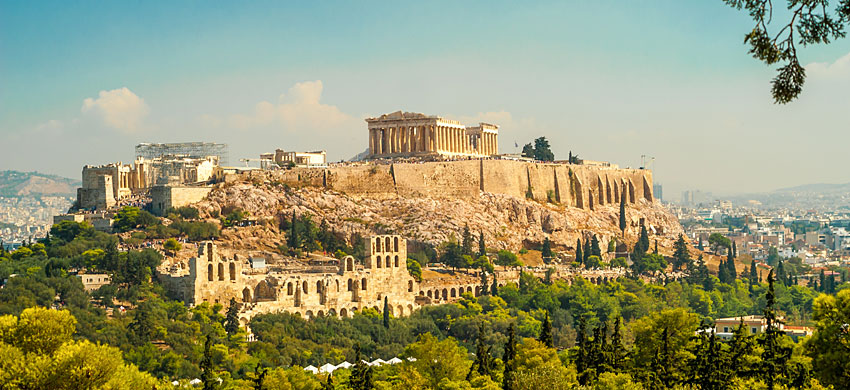
TheAcropolis of Athens is the symbol of Greece, of the splendor of its classical civilization and the most significant landmark of Greek culture. A visit to the ‘upper city’, built on the sacred hill so as to dominate the settlement, is not to be missed.
The sacred city, the Acropolis, the largest architectural and artistic complex that has come down to us from ancient Greece is located 156 meters above sea level on the flat top of a rocky promontory 140 meters wide and 28 meters long overlooking the valley of Ilissos.
Wanted in the fifth century BC by Pericles in an area where from the second millennium BC were built royal palaces and places of worship includes the four masterpieces of classical Greek art: the Parthenon built by Ictinus, the Propylaea, the monumental entrances of the sacred area dedicated to Athena, the Erechtheion and the temple of Athena Nike.
Today the Acropolis is a UNESCO World Heritage Site. The landscape is monumental and is composed of massive structures perfectly balanced with each other and with nature, creating a beautiful view.
Over the centuries the Acropolis has been damaged numerous times: first the Byzantines converted the temples into churches and plundered the treasures, then in 1456, when Athens was conquered by the Turks, the site became a mosque and the Erechtheion was used as the harem of the Turkish governor.
The episode that most damaged the Acropolis occurred in 1687 when the siege of the Venetian army caused the explosion of the Parthenon, used by the Turks as a powder keg. The plundering was completed in the 19th century by Lord Elgin, ambassador of the King of England, who brought back numerous marbles that are still the pride of the British Museum.
The best time to climb the Acropolis is at sunset: red and orange envelop the temples and the city of Athens while a light breeze cools the air.
A great vantage point of the city of Athens, stretching endlessly at your feet, is near where the Greek flag flies. Below you can see Plaka and the ruins of the Temple of Zeus.
The Acropolis stronghold is filled with temples built in the heyday of Pericles and works by Phidias, the greatest sculptor of antiquity to whom the work was entrusted. Today it is only possible to admire the remains of these works of art, but the beauty and majesty of the past can still be imagined.
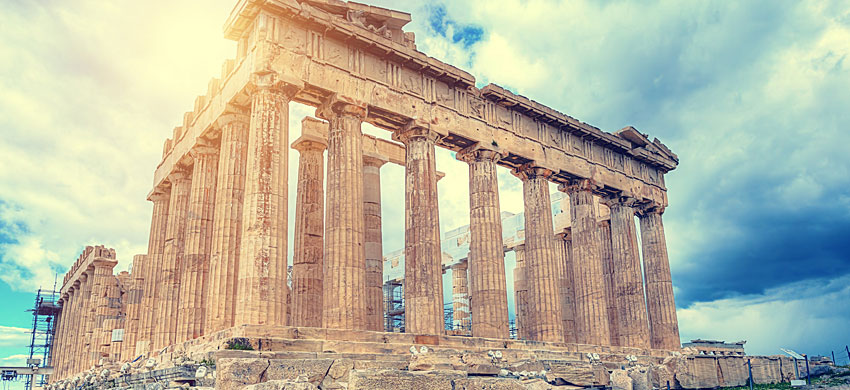
The Parthenon is the symbolic monument of the Acropolis of Athens and the whole of Greece.
Its construction is attributed to the architects Ictinus and Callicrate, under the supervision of the sculptor Phidias responsible for the entire complex, and made to date back to 447 BC when they wanted to replace an incomplete structure of which, however, was copied the type, materials and plan.
The Parthenon temple is dedicated to Athena Parthenos, the Virgin, protector of the city. The construction of the Parthenon lasted 9 years while the sculptural decoration was completed in 432 BC.
The Parthenon, the main temple of the monumental complex of the Acropolis, is in Doric style, has 8 columns of pentelic marble on each short side and 17 on the long sides and conforms to the ratio 09:04 between the vertical and horizontal proportions.
The cell is the central part of the temple and here was kept the statue of Athena sculpted by Phidias in gold and ivory. The room at the back of the cella has four columns of Ionic order supporting its roof. The introduction of elements of the Ionic order into a predominantly Doric temple was rare in Greek architecture me gave the Parthenon a delicate balance between austere and delicate visual characteristics.
In the course of the centuries the Parthenon was transformed first into a Christian church and then into a mosque until it was used by the Turks as a weapons and ammunition depot. It was just this last role to determine in 1687 a deep wound in the building: a mortar shot from a Venetian ship in siege of Athens hit the temple destroying it in large part.
To try to remedy the problems of the Acropolis in 1975 was established by the Ministry of Culture an interdisciplinary commission of experts composed of archaeologists, architects, engineers and chemists who studied and planned the execution of all the works necessary to complete the restoration of the site.
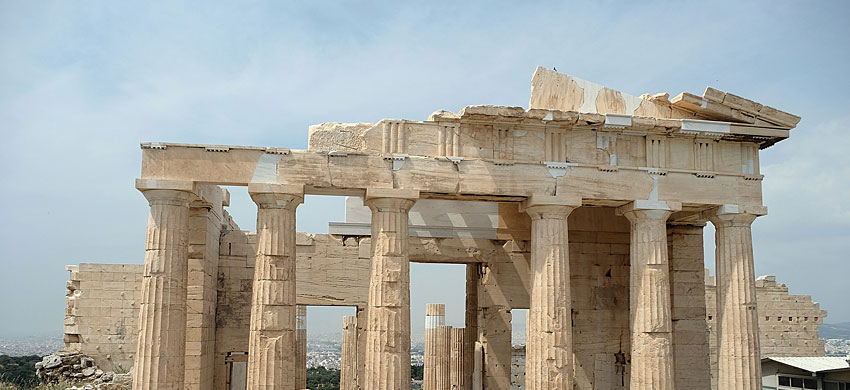
The monumental entrance to the Acropolis is the Propylaea. The entrance, designed by the architect Mnesicles, was built between 437 and 432 BC when its construction was interrupted due to the Peloponnesian War and consists of a central body and two side wings.
Constructed with the use of white Pantelian marble and grey stone from Eleusis, the Propylaea have a unique appearance and overcome the difficulties of integration both with the different elevations of the site and with the existing architecture.
The central body features six Doric columns, similar to those of the Parthenon, a corridor with three Ionic columns on either side and six Doric columns on the west exit.
The independent wings represent the unfinished part of the original project: in the northern part is the Picture Gallery, designed to be an art gallery and a place for banquets, while to the south is a simple portico.
The span of the horizontal beams of the roof of the Propylaea is particularly impressive and is much longer than the norm of Greek architecture of the time. In front of the Propylaea is a massive grey marble pedestal 10 meters high on which stood a sculpture of a chariot drawn by 4 horses in honor of the king of Pergamum.
In the course of the centuries the building was transformed first into the palace of the Byzantine bishop and in the middle of the 17th century it was used as a powder magazine. Unfortunately as a result of an explosion it was seriously damaged but thanks to restoration work the Propylaea have regained some of their former glory.
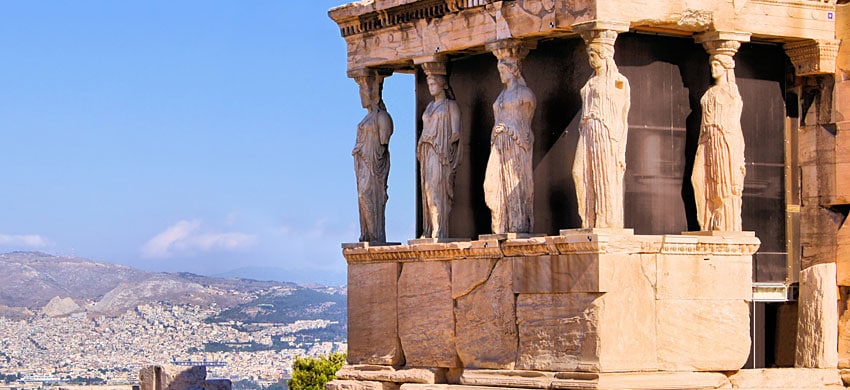
L’Erechtheion is a temple with an asymmetrical plan, due both to the irregular ground on which it stands and to the fact that it has to be integrated with numerous sanctuaries, which is located within the Acropolis combining together the Doric and Ionic styles.
The construction of this building, intended to host religious rituals, began in 42o a.. C., in full Peloponnesian War, to be completed in 406 BC. Born with the vocation of replacing the old temple, the east side of the Erechtheion was dedicated to Athena Polia while the west side was dedicated to Poseidon.
The Eretteo has delicate forms in stark contrast to the nearby Parthenon. The entrance, facing east, has 6 columns in Ionic style.
The temple is unusual in that it incorporates two porticos, one to the northwest which is supported by tall Ionic columns, and one at the southwest corner which is supported by 6 female statues about 6 meters high, the famous Caryatids. And just the Caryatids, with their sinuous shape, which seem to support with ease the weight of the entablature on their heads, have become the main feature of the Erechtheion. These female figures are exact replicas of the originals now housed in the Acropolis Museum.
The temple has an unusual continuous frieze that combines white marble figures with a dark gray marble background.
The temple of the Erechtheion has undergone important phases of reconstruction through the centuries: it was first damaged in the classical period by a great fire, then in the 7th century AD it was converted into a Christian basilica and finally during the Ottoman Empire it was converted into a harem and this involved the walling up of the portico on the north side.

The Temple of Athena Nike, with its 27 meters long and 18 meters wide, is the smallest structure of the Acropolis. Built in 420 BC by the architect Callicrates in honor of the goddess of victory, the temple has a row of 4 monolithic Ionic columns on the front and back.
The sculptural frieze depicts on three sides scenes of battles between Greeks and Persians while on the east side the relief is dedicated to the gods of Olympus intent on observing these battles.
The temple of Athena Nike rises in the southwest corner of the Acropolis, near the Propylaea, on a bastion built on a rocky spur. The structure is built in limestone covered with marble and housed the wooden statue of Apteros Nike or Victory without wings: the goddess deprived of her wings according to the ancients would never have been able to leave Athens.
The temple was transformed into a church in the fifth century AD and in the Ottoman period was used first as a munitions depot and then dismantled to build a bastion of protection near the Propylaea. In 1834 the bastion was in turn dismantled and the temple rebuilt within 4 years.
In 1998 the temple of Athena Nike underwent a deep restoration that allowed to dismantle the concrete floor built in previous years. On that occasion the frieze was removed and placed inside the Acropolis Museum.
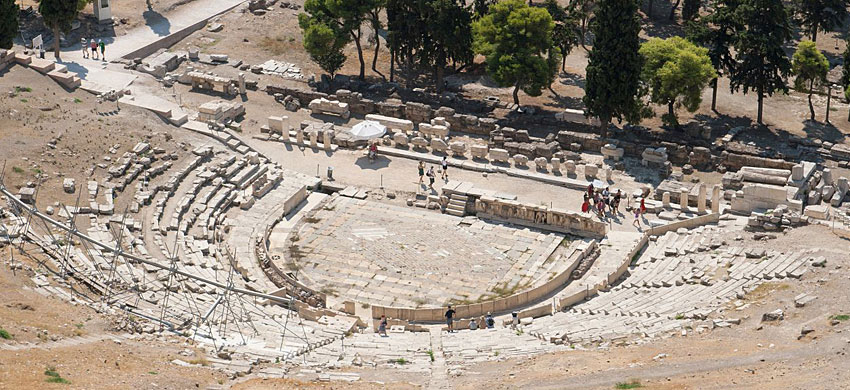
From the Acropolis one can enjoy a splendid view of the Theatre of Dionysus, lying on the southern slope of the sacred rock of the Acropolis. The theater, initially built in wood, was the fulcrum of the celebrations of the Great Dionysia and hosted the representations of the tragedies of Aeschylus, Sophocles and Euripides in addition to the comedies of Aristophanes.
Dionysus was the Greek god of wine, agriculture and theater, known to Romans as Bacchus. The theater is located in the area of the Sanctuary of Dionysus which also housed several temples dedicated to the god.
This important archaeological site was rediscovered at the end of the nineteenth century: the structure that has come down to us is mostly of Roman times but archaeologists have been able to identify as many as 9 different building phases. The theater was rebuilt in the fourth century a. C. in stone and marble: only 20 of the 64 rows prepared to accommodate the 17 thousand seats have come to our days intact.
Immediately above the theater some steps lead to the Sanctuary of Asclepius, built around a sacred spring and dedicated to the god of medicine. The cult of Asclepius was introduced in Athens in 429 B.C. while a plague epidemic was raging in the city.
Even today some tragedies are performed during the year in the enchanting setting of the Theatre of Dionysus.

The Theatre of Herod Atticus is located at the base of the Acropolis and is still used today to stage exciting classical plays. To relive the experience of ancient Greek performances, don’t miss the Athens Festival that takes place every year from June to September in this fascinating place.
Built by Herod from 161 A.D. in memory of his wife, the semicircular amphitheater on the steps arranged in 32 rows can accommodate up to 6 thousand people. A wooden roof covered in ancient times the scene of the theater 35 meters wide.
From the Acropolis you can admire the spectacle of the small theater of Herod that still retains its classic and traditional design. The Odeon has hosted performances by Maria Callas and the Bolshoi Theater Ballet but also modern artists such as Elton John, Sting and many others.
Children under the age of 6 are not allowed to enter.
The ancient foundations of a temple dating back to the 6th century BC can be seen in the center of the Acropolis between the Parthenon and the Erechtheion. The ancient Temple of Athena Poliàs was the centerpiece of the cult of the patron goddess of the city of Athens: for the ancient Greeks she embodied wisdom, courage, inspiration, civilization, law and justice but also war, mathematics, strength, strategy, arts and crafts.
Built and destroyed several times, the temple was in Doric order and had a marble pediment. In 480 BC it was finally demolished and replaced with the Erechtheion, although several sculptures, depicting mythological events, have come down through the centuries to us.
The ancient temple of Athena was oriented on the west-east axis: the sides measured 21.3 and 43.15 and were adorned with 6 columns on the short side and 12 on the long side. The foundations are composed of various materials and built in different techniques and this makes it difficult to reconstruct the architectural history of the building.
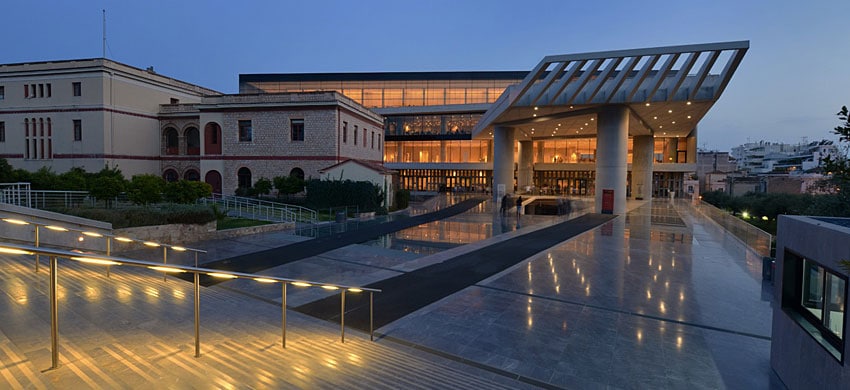
The Acropolis Museum is located about a kilometer away from the Parthenon, in the Makryianni district, among several archaeological sites including the ruins of the fifth century AD visible in the heart of the same structure through the glass floor of the second floor.
The new and modern building, inaugurated in 2009, houses about 8 thousand square meters of exhibition, mainly sculptural.
From prehistory to late antiquity, life on the Acropolis is narrated in the Museum: from works of sculpture to the decorative architectural elements of the monuments.
The collection of the Acropolis Museum is installed in a simple way and the path for the visitor is clear. On the third level is the Parthenon room where the sculptures and the Parthenon frieze, brought back to Greece from England after the plundering of Sir Elgin, are exhibited.
The museum also offers some services: bar, restaurant and gift store.
In the following map you can see the location of the main places of interest mentioned in this article.
The Acropolis is themost visited attraction in Athens and all of Greece: to visit it you need to buy an entrance ticket or take part in a guided tour. There are different types of tickets: choose the one that suits you! We recommend that you visit during off-peak times, i.e. early morning or late afternoon.
Due to the high number of tourists at the Acropolis, it is highly recommended to book your ticket in advance directly online, by clicking on the box below. By purchasing your ticket online you will avoid the long lines that form every day at the ticket offices.
Alternatively, to discover everything about the marvelous Acropolis you can request an audio guide or have an expert guide accompany you during your visit. The cost is a little higher than the entrance ticket, and even buying these tickets will save you time by avoiding standing in line at the ticket office.
If, in addition to the Acropolis, you want to visit other Athens attractions, such as the Acropolis Museum or the Agora, the combination ticket is ideal for saving money on individual admissions and skipping the line at all ticket offices.
Reaching the Acropolis is easy and pleasant: large pedestrian avenues, animated by cafes and restaurants, rise from the district of Thisio and Makrianni. From Plaka and Monastiraki the climb is quieter but always immersed in nature. From the gate at the base of the sacred rock you will have to walk up a flight of steps to reach the actual entrance to the archaeological site.